42-mm Nikon EDG II Binoculars
|
|
Review Highlights
- Nikon’s
finest binocular ever
- Startlingly
bright, vivid images
- Amazing
depth of field
- Huge
field of view
- Great
design – easy and comfortable to use
|
The Germans and Austrians have long dominated the top-end binocular market and rightfully so. There was a clear difference in quality and no others challenged their wares.
Traditionally, the most critical buyers and those who demanded only the best sports optics needed look no further than the top three European manufacturers. Well, the world
has changed. Be there no question, with the introduction of the Nikon EDG binoculars, the top trio became a quartet. However, Nikon has discontinued the EDG II binocular series,
so your choices for alpha glass reverts back to the Germans and Austrians.
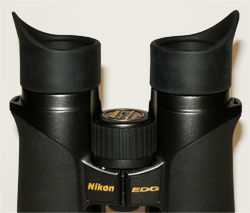
Nikon is well known in the camera world as one of the finest optics manufacturers. In the case of the EDG II binoculars, that expertise comes through in flying colors.
Bright, vivid, gripping colors. For you “Nikonites”, the EDG II is the binocular you’ve always waited for, and maybe for the rest of us too. What you see is the single most
crucial factor in evaluating any binocular, barring any glaring problems in their basic function. The new EDG II binoculars stand out optically in all aspects. It is the
richness of the image, the sharpness, the stunning detail that makes a profound impression. The quality of the view puts these binoculars in a very elite class.
The
Glass
The EDG II name was derived
from ED Glass which is ‘extra-low dispersion’ or
‘extra-high density’ glass – however you want to think of it. This
type of glass is often seen in high- end spotting scopes and camera lenses
and is appearing more often in binoculars. ED glass reduces the scatter
and separation of the different wavelengths of light so that they all
arrive simultaneously on the same focal plane: your pupil. This limits
the green/magenta color fringes, called chromatic aberration, around high-contrast
objects and at the edges of the field. You will also see a difference
in something that you might not associate with chromatic aberration: its
absence results in a sharper image.
Field
of View
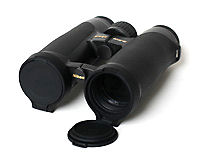 Another impressive optical quality of the EDG II binoculars is their extensive
depth of field. This is one of those things that we rarely write about
because it is so hard to quantify. When you have focused on a particular
object, depth of field comprises all that is in focus both in front of
and behind that object. Binoculars with shallow depth of field cause the
user to constantly adjust focus, particularly with objects closer to the
observer. Additionally, with a shallow depth of field, the user must be
more precise in focusing since there is less room for error. Greater depth
of field results in an enhanced three-dimensional perspective. While small
differences in depth of field are virtually impossible to quantify, big
differences are readily apparent. The EDG II binoculars have simply stunning
depth of field; in this, they exceeded all competitors. Still another
property of the EDG II binoculars is their huge field of view. Nikon published
the following numbers for the field of view at 1000 yards: 419 feet for
the 7x42, 403 feet for the 8x42, and 341 feet on the 10x42. All of those
are about average for 42-mm binoculars at those respective magnifications.
So the numbers look good although in our experience, what a manufacturer
says and what it means in terms of field performance are difficult to
measure, and sometimes hard to even see. What we can say is that we tested
them in the field and they did have a larger usable field of view than
their competitors. The incredible image quality and extensive depth of
field mean that, with the EDG II you see more of what you’re looking
for than with most high-end binoculars.
Another impressive optical quality of the EDG II binoculars is their extensive
depth of field. This is one of those things that we rarely write about
because it is so hard to quantify. When you have focused on a particular
object, depth of field comprises all that is in focus both in front of
and behind that object. Binoculars with shallow depth of field cause the
user to constantly adjust focus, particularly with objects closer to the
observer. Additionally, with a shallow depth of field, the user must be
more precise in focusing since there is less room for error. Greater depth
of field results in an enhanced three-dimensional perspective. While small
differences in depth of field are virtually impossible to quantify, big
differences are readily apparent. The EDG II binoculars have simply stunning
depth of field; in this, they exceeded all competitors. Still another
property of the EDG II binoculars is their huge field of view. Nikon published
the following numbers for the field of view at 1000 yards: 419 feet for
the 7x42, 403 feet for the 8x42, and 341 feet on the 10x42. All of those
are about average for 42-mm binoculars at those respective magnifications.
So the numbers look good although in our experience, what a manufacturer
says and what it means in terms of field performance are difficult to
measure, and sometimes hard to even see. What we can say is that we tested
them in the field and they did have a larger usable field of view than
their competitors. The incredible image quality and extensive depth of
field mean that, with the EDG II you see more of what you’re looking
for than with most high-end binoculars.
Image
Quality
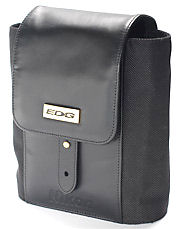 Image brightness always ranks very high on the list of critical optical
performance parameters. Many factors combine to produce image brightness,
ranging from the quality of glass and coatings to the physical assembly
of the prisms, and so on. When looking strictly at image brightness, the
EDG II binoculars, though bright, were not the brightest binoculars we
tested. We qualify this last statement: the EDG II are very bright and
of those we tested, only one binocular was marginally brighter. That being
said, it was a big surprise to us that, despite another binocular delivering
a brighter image, the EDG II consistently outperformed the brighter binocular.
The EDG II produced more image detail and greater richness than the brighter
binocular in all light conditions. We’re still not even sure how that
is possible! But we all saw it, and seeing is believing, right?
Image brightness always ranks very high on the list of critical optical
performance parameters. Many factors combine to produce image brightness,
ranging from the quality of glass and coatings to the physical assembly
of the prisms, and so on. When looking strictly at image brightness, the
EDG II binoculars, though bright, were not the brightest binoculars we
tested. We qualify this last statement: the EDG II are very bright and
of those we tested, only one binocular was marginally brighter. That being
said, it was a big surprise to us that, despite another binocular delivering
a brighter image, the EDG II consistently outperformed the brighter binocular.
The EDG II produced more image detail and greater richness than the brighter
binocular in all light conditions. We’re still not even sure how that
is possible! But we all saw it, and seeing is believing, right?
Close
Focus
In reading the published specifications
for the EDG II, one number really turned us off: the 9.8-foot minimum
close focus. We use our binoculars to observe nature and we want to look
at everything from birds to butterflies, bugs, flowers or moss on trees…
If we have to be 10 feet away to focus, we just can’t see details on
small things or get close enough to see subtle features. Minimum close
focus is something that manufacturers often seem overly conservative with,
perhaps because perception of it varies with the observer. We often qualify
our discussion of close focus by noting the distance at which the visual
field deteriorates either by separating into multiple images or going
partially dark. With that in mind, we don’t know how Nikon got 9.8 feet
for their minimum close focus! All of us got down to about 7 feet plus
or minus an inch without any visual field collapse. While 7 feet isn’t
the world’s shortest minimum close focus, it’s good enough, and it’s
a lot better than 9.8 feet!
Flat
Field Performance
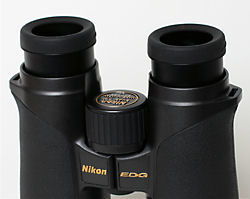 Rollover image with mouse
Rollover image with mouse
In flat-field performance,
the EDG II binoculars are good, though not as good as their cousins, the
Nikon Premier LXL, which are pretty much the best ever in this character.
There was almost no detectable pin-cushioning or barrel distortions (see
the All About Optics
section on the site for definitions). The distortions were negligible
overall, even at field edge where all binoculars show some.
Design
Stepping back, one of the first
things you’ll notice about the EDG II is that, unlike the original EDG,
it no longer has an “open bridge” or “double-hinge” design. This change
was forced by a patent infringement case.
Size
And Weight
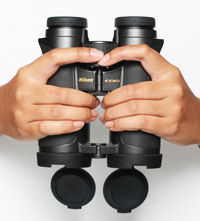 EDG
binoculars are offered in five different models: 8x and 10x32, and the
8x, and 10x42 versions. We won’t say much about the 32-mm EDG II models
since that’s a subject for a separate review. The 42-mm versions are
of average dimensions: 5.1 inches wide by 5.9 inches tall with eyecups
fully down, (6.4 inches with them up). The 8x EDG II weigh in at 28.6
oz. and the 10x model at 28.9 oz. This is slightly greater than the 25-26
oz. we would prefer to see in a top 42-mm binocular but the EDG II are
so well-balanced and comfortable in hand that they just don’t feel as
heavy as the scale says they are. This brings up two things that are worthy
of note: the first is balance. How a binocular distributes its weight
in your hand determines how much fatigue it causes in your arm. Our review
team spent long days birding with the EDG II (is this a great job, or
what!) without significant fatigue. If someone actually experienced neck
fatigue, it could be quickly cured by using a harness. The second thing
we need to comment on is shape and external coating, which affects how
comfortable a binocular feels in the hand. The soft rubber armoring of
the EDG II has the same almost-sticky feel to it that the Premier LXLs
had. We happen to like it, and see it as a plus. There are also thumb
recesses well positioned on the underside of the barrels for greater comfort.
The EDG II have a magnesium body, touted by Nikon as ultra durable. Additionally,
the EDG II are fully sealed and nitrogen-purged to be waterproof, dust-proof
and internally fog-proof.
EDG
binoculars are offered in five different models: 8x and 10x32, and the
8x, and 10x42 versions. We won’t say much about the 32-mm EDG II models
since that’s a subject for a separate review. The 42-mm versions are
of average dimensions: 5.1 inches wide by 5.9 inches tall with eyecups
fully down, (6.4 inches with them up). The 8x EDG II weigh in at 28.6
oz. and the 10x model at 28.9 oz. This is slightly greater than the 25-26
oz. we would prefer to see in a top 42-mm binocular but the EDG II are
so well-balanced and comfortable in hand that they just don’t feel as
heavy as the scale says they are. This brings up two things that are worthy
of note: the first is balance. How a binocular distributes its weight
in your hand determines how much fatigue it causes in your arm. Our review
team spent long days birding with the EDG II (is this a great job, or
what!) without significant fatigue. If someone actually experienced neck
fatigue, it could be quickly cured by using a harness. The second thing
we need to comment on is shape and external coating, which affects how
comfortable a binocular feels in the hand. The soft rubber armoring of
the EDG II has the same almost-sticky feel to it that the Premier LXLs
had. We happen to like it, and see it as a plus. There are also thumb
recesses well positioned on the underside of the barrels for greater comfort.
The EDG II have a magnesium body, touted by Nikon as ultra durable. Additionally,
the EDG II are fully sealed and nitrogen-purged to be waterproof, dust-proof
and internally fog-proof.
Physical
Properties
Other physical properties include
eye relief, which is more than adequate for all models, at 19.3 mm and
18.0 mm for the 8x and 10x respectively. The 42-mm EDG II binoculars go
from minimum close focus to infinity in a zippy 1.2 turns of the focus
knob, with an action that is smooth and effortless right out of the box.
You have to score them highly for focusing speed and ease. The eyecups
adjust helically, with three positions in addition to fully-in, all marked
by nice, firm detents. The eyecups were very well executed and engineered.
Included in the box are also soft rubber wrap-around eyecups that can
help reduce stray light from the sides for non-eyeglass wearers. EDG II
binoculars have a large interpupillary distance range of 53-74 mm. This
is very nice, especially on the low end, where people with close-set eyes
often have trouble finding binoculars that fit their face.
Diopter
Adjustment
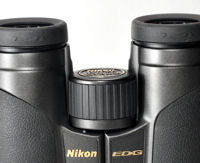 Rollover image with mouse
Rollover image with mouse
The diopter adjustment on EDG
II binoculars is built into the focus knob and is accessed by pulling
the knob upward from the hinge to expose the dial that adjusts the diopter.
That dial has a nice action and is clearly marked, and while it doesn’t
lock in place, it doesn’t need to since it is hidden by the focus knob.
Integrated center focus/diopter mechanisms are becoming more common, especially
in high-end binoculars. We think this design has downsides relative to
locking diopter controls located on the oculars. In the initial version
of the EDG II, the focus knob popped up way too easily and disengaged
focusing. Nikon fixed this in the more recent models. This doesn’t negate
the issues we have with center focus/diopter adjustments, but at least
it is a vast improvement over the previous version.
Cover
and Case
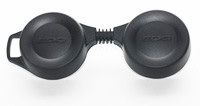 Another
thing Nikon fixed with their recent upgrades to the EDG II is the rain
guard. The first one was very innovative but ultimately unsuccessful.
The old rain guard was made of hard plastic that clacked noisily against
the binocular as one walked. This rain guard has been replaced with a
soft rubber one that fits a bit loosely over the oculars but adequately
covers them. It’s simple, effective and a big improvement. Nikon also
included “winged” eyecups for users who don’t wear glasses as standard
equipment with the EDG II binoculars. Although the rain guard does not
fit over them, Nikon anticipated this limitation and thoughtfully provided
two hard plastic caps that fit fairly snugly inside these eyecups. It
is another nice addition that Nikon provides as standard equipment rather
than as an accessory to be purchased. Some people will like them and use
them, and others won’t, but at least everyone gets the option. We give
them high marks for anticipating users needs.
Another
thing Nikon fixed with their recent upgrades to the EDG II is the rain
guard. The first one was very innovative but ultimately unsuccessful.
The old rain guard was made of hard plastic that clacked noisily against
the binocular as one walked. This rain guard has been replaced with a
soft rubber one that fits a bit loosely over the oculars but adequately
covers them. It’s simple, effective and a big improvement. Nikon also
included “winged” eyecups for users who don’t wear glasses as standard
equipment with the EDG II binoculars. Although the rain guard does not
fit over them, Nikon anticipated this limitation and thoughtfully provided
two hard plastic caps that fit fairly snugly inside these eyecups. It
is another nice addition that Nikon provides as standard equipment rather
than as an accessory to be purchased. Some people will like them and use
them, and others won’t, but at least everyone gets the option. We give
them high marks for anticipating users needs.
The objective lens caps are
hinged and they fit onto a stiff rubber ring that attaches over the barrel
ends. These lens caps swing out when the binocular is in use or snap closed;
in that, they work pretty well. The issue is that when they are open,
they tend to snag on things, often pulling the entire assembly, cap and
ring, right off. Since you don’t always know that this has happened,
in effect, they tend to promote the one thing they were designed to prevent:
loss of lens caps in the field. So this was a good idea that needs a bit
better execution. We hope Nikon is generous about replacing these upon
request until they figure a fix for it. The strap is a hybrid of neoprene
rubber and wide cordura that tapers down to fit through the well-positioned
lugs on the sides of the barrels. It is fairly comfortable by itself,
though some users may still prefer a harness-type strap. Lastly, there
is the case, which is made of soft leather and cordura and is well padded
inside. We have qualms about the elaborate flap-closure mechanism. The
flap has a strap with two holes in it that fit over a small post riveted
into the outer portion of the case. A double-toothed clasp of the type
common on backpacks would have been better. While the case is very classy
overall, Nikon over-engineered it, and a simpler approach could have been
a lot more functional. Then again, no one buys binoculars this good for
the case!
Conclusions
The Nikon EDG II binoculars were priced quite reasonably for high-end binoculars. The lowest internet price was $2399.95 for the 8x42 EDG II
and $2499.95 for the 10x42. Price and performance made the EDG II an appropriate choice for those who demand nothing but the best.
Overall we are extremely impressed with the Nikon EDG II binoculars. Their optical performance meets or exceeds that of the best binoculars on
the market today in every aspect. The design is innovative and thought out down to the finest detail. They are razor sharp, bright, clear and
vivid. The amazing depth of field seemingly inserts the viewer in the view. The EDG II binoculars are more than just Nikon’s entry into the
high performance binocular market: they are the cutting edge.
Nikon has discontinued the EDG II binoculars, and they are no longer available. If you've had them on your wish list, you're too late.
Conact us for suitable replacements.